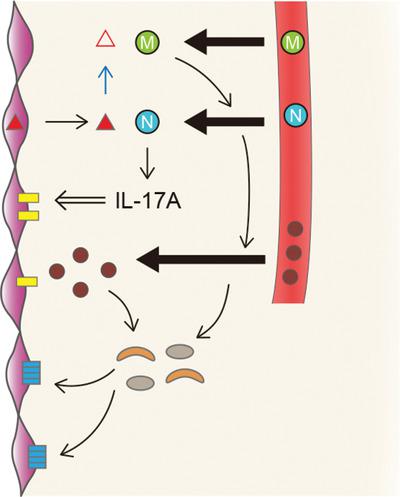Our official English website, www.x-mol.net, welcomes your
feedback! (Note: you will need to create a separate account there.)
Rheumatoid arthritis: Development after the emergence of a chemokine for neutrophils in the synovium
BioEssays ( IF 3.2 ) Pub Date : 2021-08-25 , DOI: 10.1002/bies.202100119 Hiroshi Katayama 1
BioEssays ( IF 3.2 ) Pub Date : 2021-08-25 , DOI: 10.1002/bies.202100119 Hiroshi Katayama 1
Affiliation

|
Rheumatoid arthritis (RA) may not be a multifactorial disease; it can be hypothesized that RA is developed through a series of events following a triggering event, which is the emergence of a chemokine for neutrophils in the synovium. IL-17A, secreted by infiltrated neutrophils, stimulates synoviocytes to produce CCL20, which attracts various CCR6-expressing cells, including Th17 cells. Monocytes (macrophages) appear after neutrophil infiltration according to the natural course of inflammation and secrete IL-1β and TNFα. Then, IL-17A, IL-1β, and TNFα stimulate synoviocytes to produce CCL20, amplifying the inflammation. Varieties of chemokines secreted by infiltrating cells accumulate in the synovium and induce synoviocyte proliferation by binding to the corresponding G protein-coupled receptors, thus expanding the synovial tissue. CCL20 in this tissue attracts circulating monocytes that express both CCR6 and receptor activator of NF-κB (RANK), which differentiate into osteoclasts in the presence of RANKL. In this way, pannus is formed, and bone destruction begins.
中文翻译:

类风湿性关节炎:滑膜中嗜中性粒细胞趋化因子出现后的发展
类风湿性关节炎 (RA) 可能不是一种多因素疾病;可以假设 RA 是通过触发事件之后的一系列事件发展而来的,触发事件是滑膜中嗜中性粒细胞趋化因子的出现。由浸润的中性粒细胞分泌的 IL-17A 刺激滑膜细胞产生 CCL20,从而吸引各种 CCR6 表达细胞,包括 Th17 细胞。根据炎症的自然过程,在嗜中性粒细胞浸润后出现单核细胞(巨噬细胞)并分泌 IL-1β 和 TNFα。然后,IL-17A、IL-1β 和 TNFα 刺激滑膜细胞产生 CCL20,从而放大炎症。浸润细胞分泌的多种趋化因子积聚在滑膜中,通过与相应的G蛋白偶联受体结合,诱导滑膜细胞增殖,从而扩大滑膜组织。该组织中的 CCL20 吸引循环单核细胞,这些单核细胞表达 CCR6 和 NF-κB 受体激活剂 (RANK),在 RANKL 存在的情况下,它们分化为破骨细胞。这样,血管翳形成,骨质破坏开始。
更新日期:2021-09-27
中文翻译:

类风湿性关节炎:滑膜中嗜中性粒细胞趋化因子出现后的发展
类风湿性关节炎 (RA) 可能不是一种多因素疾病;可以假设 RA 是通过触发事件之后的一系列事件发展而来的,触发事件是滑膜中嗜中性粒细胞趋化因子的出现。由浸润的中性粒细胞分泌的 IL-17A 刺激滑膜细胞产生 CCL20,从而吸引各种 CCR6 表达细胞,包括 Th17 细胞。根据炎症的自然过程,在嗜中性粒细胞浸润后出现单核细胞(巨噬细胞)并分泌 IL-1β 和 TNFα。然后,IL-17A、IL-1β 和 TNFα 刺激滑膜细胞产生 CCL20,从而放大炎症。浸润细胞分泌的多种趋化因子积聚在滑膜中,通过与相应的G蛋白偶联受体结合,诱导滑膜细胞增殖,从而扩大滑膜组织。该组织中的 CCL20 吸引循环单核细胞,这些单核细胞表达 CCR6 和 NF-κB 受体激活剂 (RANK),在 RANKL 存在的情况下,它们分化为破骨细胞。这样,血管翳形成,骨质破坏开始。











































 京公网安备 11010802027423号
京公网安备 11010802027423号